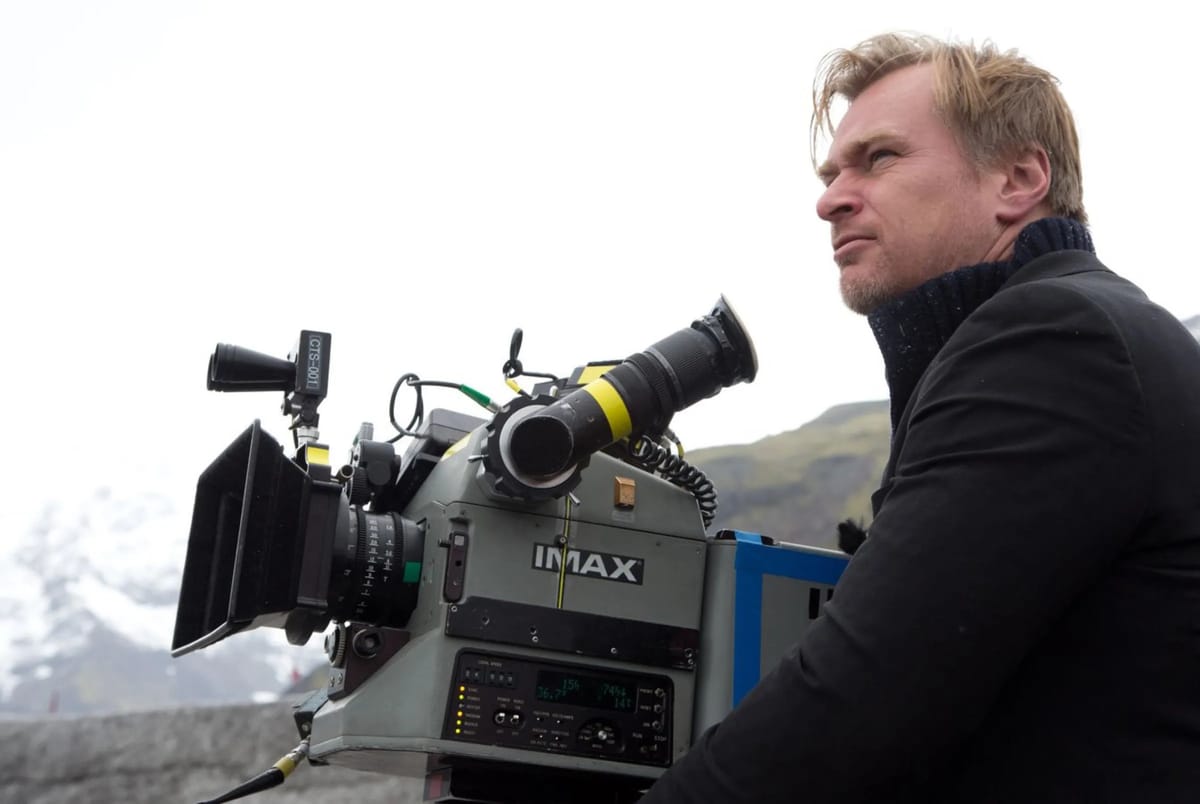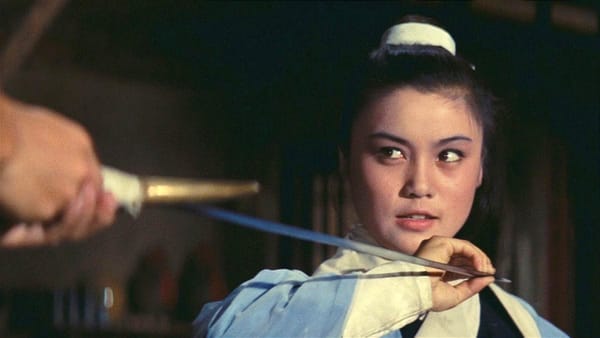The Creative Inconveniences of IMAX
While its popularity is exploding, IMAX is still a cumbersome, disorganized format. Its lack of convenience, though, has become a channel for creativity.

Large format film is exploding. Once the year is over there will have been more than a dozen films released worldwide in 2025 that were filmed at least partially with IMAX cameras. To put that in perspective, before 2020 there had only been 22 traditional theatrical releases to have ever used IMAX cameras. But despite the format’s growing popularity, we are still in the technology’s Wild West days. Its capabilities have been proven, its profitability demonstrated, and yet filmmakers are still working out the kinks of how to make a movie in IMAX. The format has not fully integrated with the rest of the filmmaking apparatus, and because of that the choice of how and when to use it has become a storytelling device, one that presents its own challenges and opportunities.
Most general audience members probably don’t know what IMAX even is exactly, beyond a premium format with a really large screen that costs more money than a regular ticket and is therefore supposed to be better. The truth is that IMAX is a lot of different things that encompasses many different technologies, from cameras to film formats to projectors and auditoriums. Go to the IMAX website right now and you’ll find listings for movies that were made in entirely different ways, where the experience you get will vary depending on the theater you visit. The website unhelpfully clarifies very little of this. “Filmed for IMAX” and “Shot with IMAX” mean completely different things. It can all get very complicated very quickly.
The Art Newsletter
Creativity. Culture. Community.
Unlock independent analysis trusted by curious minds worldwide become a paid supporter and get access to our full content library. Every Thursday, we send a carefully curated drop of stories, tools, and creative insight for the next generation of artists, musicians, filmmakers, designers, and thinkers.
Join a global community of readers who never settle for surface-level stories.
I am not going to explain all of the different types of IMAX film and their various characteristics – there are plenty of pieces already on the internet that can do that for you – but for the sake of this article I do need to emphasize two things. First, there are some films that get made and then get converted into an IMAX format once they’re finished, and some films that are shot with IMAX cameras and designed specifically to be seen on IMAX screens. It is this latter type of film that I am focusing on here, and I want to focus mostly on movies made with IMAX film cameras (as opposed to IMAX digital cameras). Second, one of the distinctive characteristics of IMAX footage is its aspect ratio, which is among the tallest existing formats at 1.43:1. (Though unless you live near one of the 75 or so commercial theaters in the world that can show IMAX at that aspect ratio, you’re instead going to see the IMAX footage at 1.90:1. Like I said, this gets complicated.)
IMAX 70mm 15-perf film is probably the most celebrated film format in the world right now. That’s the one for which Christopher Nolan has been banging the drum for about 20 years. And it’s celebrated for good reason. It combines all the detail and scale of IMAX technology with the traditional benefits of large format film stock, especially the ability to capture much of the background environment in a shot while using telephoto lenses. But shooting on this format is also a gigantic pain. The cameras can only hold reels containing up to about two minutes of film, meaning they essentially have to be reloaded after every take (traditional 35mm cameras, by contrast, usually hold about 20 minutes of film). They are notoriously bulky and difficult to operate. And most significantly, they are loud. Loud enough that you can forget about recording sync sound when you’re using them, and will have to ADR any dialogue in those scenes. All this means that shooting an entire feature film in IMAX has long been a practical impossibility. So when shooting for IMAX, filmmakers have to choose which parts to film in IMAX and which parts to shoot in another format. They have to choose what that other format is going to be, and how they are going to navigate the relationship between the two formats. And here is where the inconvenience of the format becomes an opportunity for creative choices.
The critical aspect in so many of these decisions is aspect ratios. The 1.43:1 aspect ratio is basically never used outside of IMAX movies, and so all the non-IMAX parts of the film, as well as all the non-IMAX versions of the film, are going to be in a different, almost certainly wider, aspect ratio. This impacts the filmmaking in a couple ways, first concerning the way the IMAX scenes themselves are shot. Even when shooting for IMAX, filmmakers are aware that the majority of viewers will probably not see the film in IMAX, and an even vaster majority will not see it in the full 1.43:1 aspect ratio. (It’s another worthy discussion to consider whether it’s a good idea to design a film for a format that so little of its audience will actually see it in.) So they need to compose their shots such that the image will still work in a wider aspect ratio with the top and bottom chopped off. This generally means that close-ups never get too close (a format this large can get the effect of a close-up from a medium shot anyway), and that there’s an incentive to place important subjects near the center of the frame. This might somewhat restrict the cinematography, forcing it wider and more restrained, but on the other hand such a limitation can end up helping a filmmaker, forcing them to pay special attention to their composition.
The other major area where the different aspect ratios become significant is at the transition points between these aspect ratios, between the IMAX and non-IMAX scenes. And interestingly, the filmmaker who has historically struggled the most with these transitions is Christopher Nolan. Here, Nolan’s love of the format actually works against him, as he seems so intent on having as much of the film in IMAX as possible that he shoves IMAX shots and sequences into the film anywhere he can regardless of their surrounding context. The result, particularly in some of his earlier works with substantial IMAX like The Dark Knight Rises and Interstellar, is that the film keeps switching back and forth between aspect ratios the entire runtime, sometimes even for individual shots within the same scene. There is no rhyme or reason behind these constant changes; they are simply the result of the doctrine that if a shot can be in IMAX, it will be in IMAX. The irony here is that Nolan’s cinematic goal throughout most of his career, and the main reason for his love of IMAX in the first place, is total immersion, but this very choice to use the format to the practical maximum and make the aspect ratio oscillate like an overcharged metronome becomes a major source of distraction.
There are other filmmakers, though, who have been more discerning with their choices of when to use IMAX, and who have thus turned the transition into and out of IMAX as a storytelling device. Ryan Coogler faced a real challenge with aspect ratios when shooting Sinners, as his choice of the super-wide Ultra Panavision 70mm format and its 2.76:1 aspect ratio for the non-IMAX scenes marked the largest disparity so far between a film’s IMAX and non-IMAX aspect ratios. Any change between the two would be highly noticeable. Accordingly, Sinners is much more careful than a Nolan film about when and how to switch between formats. Cuts between a Panavision and an IMAX shot do not just come between scenes, but serve as punctuation that mark off one chapter of the film and signal a transition into the next one. A cut to a taller IMAX image signals to the audience to pay attention, to lock into the film. Such a cut is used to great effect, for example, to open the scene that introduces Remmick, the film’s main villain.
But there are also the more dynamic transitions into IMAX, where the edges of the frame expand within a single shot. Sinners has a couple of these, and the one that occurs as Sammie begins to tap into ancestral spirits during his performance at the juke joint is particularly effective, with the expanding aspect ratio mirroring the ascendance into a plane of artistic ecstasy the scene depicts. The later Mission: Impossible films have also excelled in these in-shot IMAX transitions to mark sequences of the film’s major stunts. In Fallout’s HALO jump, the aspect ratio expands at the camera follows Ethan jumping out of the plane. And this year’s The Final Reckoning has the most creative transition I have yet seen to open its submarine sequence. Ethan yanks a wheel a few times to open the outer door of his submarine’s airlock, and with each yank of the wheel the aspect ratio expands out just a little bit more.
Top prize for most effective transition into IMAX, though, goes to the lone ten-minute IMAX sequence of Neil Armstrong’s moonwalk in First Man. The transition comes in what feels like a POV shot as the landing module opens its door on the moon for the first time. In just a couple seconds, the door opens, the camera flies through it, the aspect ratio expands, and the film goes dead silent as we stare out onto the lunar surface in IMAX. The adrenaline of the moment is so great you likely don’t even notice the aspect ratio changing, but it has all the effect of Dorothy opening the door into Oz, the sudden expanded image perfectly conveying the vastness and desolateness of this landscape onto which no human has yet ventured. This is the clearest example I can find of an IMAX image being used not just for its spectacle and grandeur, but as a true cinematic storytelling device that all by itself conveys meaning and feeling.
The creative choices that lead to moments like these only ever became necessary, though, because of the complications the current state of IMAX brings. It is because there are so few theaters in the world with the technology to project a full IMAX image that attention to composition becomes important. It is because the film cameras are so loud and bulky that shooting a feature on IMAX film becomes impractical, and transitions between formats within a film have to be considered. But the necessity of those choices depends on the state of the technology, and the technology is changing.
When Christopher Nolan’s The Odyssey releases next July, it will become the first commercial feature to be shot entirely with IMAX 70mm film cameras. Nolan won’t have to worry about the distraction of changing aspect ratios because everything will now be in IMAX. And making such a film is now possible because IMAX made cameras for Nolan that are lighter and allegedly 30% quieter than previous models. This is of course very exciting. Nolan and his cinematographer Hoyte van Hoytema have done tremendous work with the IMAX format, and I am eager to see what more they can do freed from some of their technological limitations. More generally, we are sure to get more great work in the format as it becomes more accessible and less onerous. But freedom can come at a price, and a lack of inconvenience might cause filmmakers to overlook potential creative choices they otherwise would have been forced to make.
The rise of IMAX over the past couple decades mirrors in many ways the first boom in large format film in the 1950s, with formats like Cinerama and CinemaScope. Much of the impetus for such formats was the rise of television, as studios tried to lure audiences back to theaters with spectacles whose scale a TV set could never replicate. The recent rise of streaming may play a similar role in the IMAX boom. One of the new formats that arose in the ‘50s was VistaVision, a widescreen 35mm format that, like IMAX, ran film horizontally through the camera to get better resolution. The format lasted less than ten years, though, before it was overtaken by formats that had better compatibility with standard projection equipment. (It is now undergoing a recent revival thanks to films like The Brutalist and One Battle After Another, further contributing to our large-format renaissance.)
One of the most important films shot in VistaVision was John Ford’s The Searchers, which opens with another stepping-into-Oz type shot. From darkness we see a door open to the outside, then the camera moves through that door to reveal the brilliant widescreen grandeur of Monument Valley. Like many Westerns, the film focuses on the thematic dichotomy of the home against the frontier, with John Wayne’s Ethan Edwards the kind of violent avenger who has no place in a civilized domestic life but fits perfectly into the wild frontier he tames to make room for that domestic life. The film’s iconic final shot mirrors its opening; while the other characters happily return home, Ethan remains outside, wanders back into the wild, and the door closes to shut him out of domestic life.
The story The Searchers tells in these shots may well be the story of its own film format, and might bear even more pertinence to the IMAX format that has spiritually succeeded VistaVision. Right now, we are still in a frontier era of large-format film, where means of shooting and especially theatrical exhibition have not been fully standardized, and shooting in IMAX is a rough and cumbersome battle. But as our large-format technology is advancing, the frontier is shrinking. We are moving towards a more secure, civilized era of large-format film. In many respects, this is cause for celebration. But spare a thought for those filmmaking practices that, like Ethan, will be left behind as a result, made to wander a untamed landscape that is getting smaller by the day.





